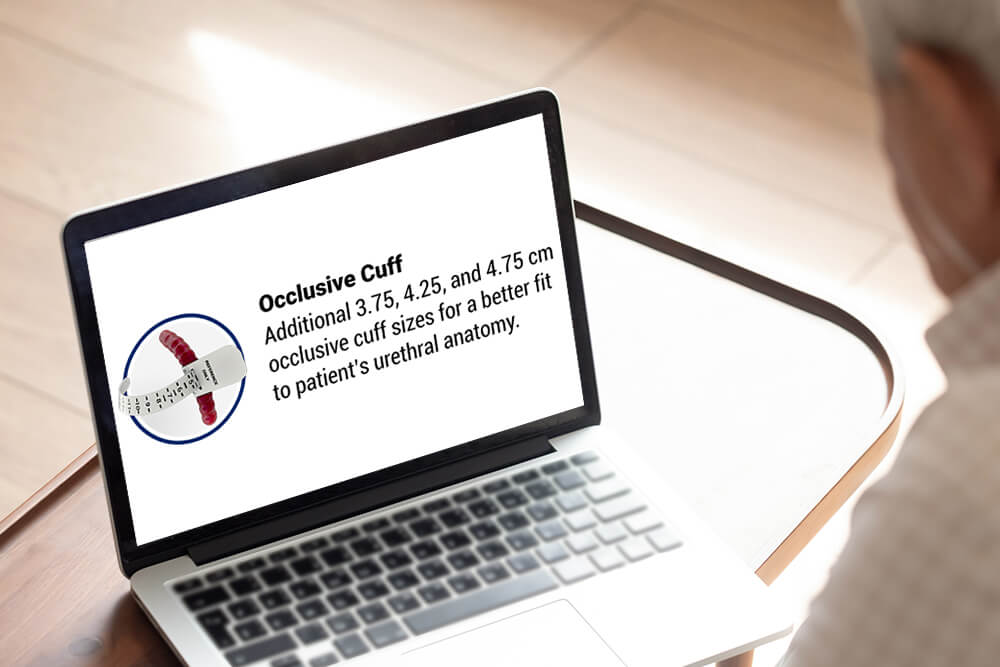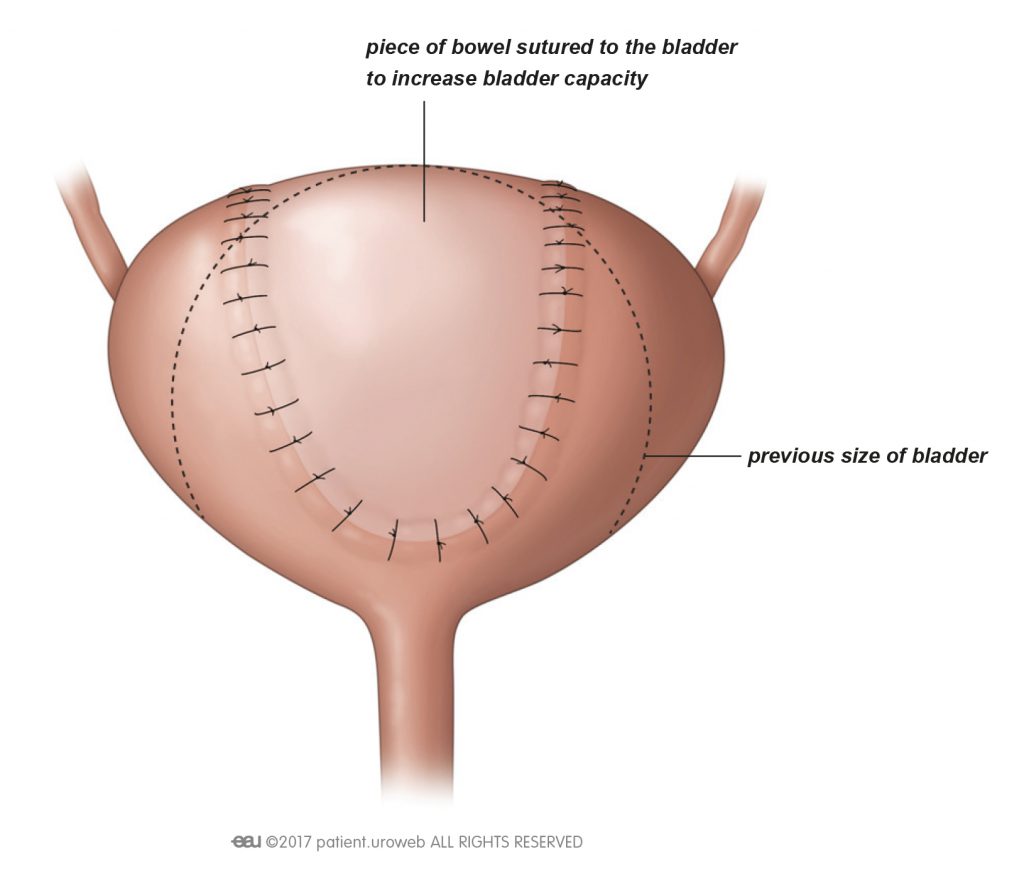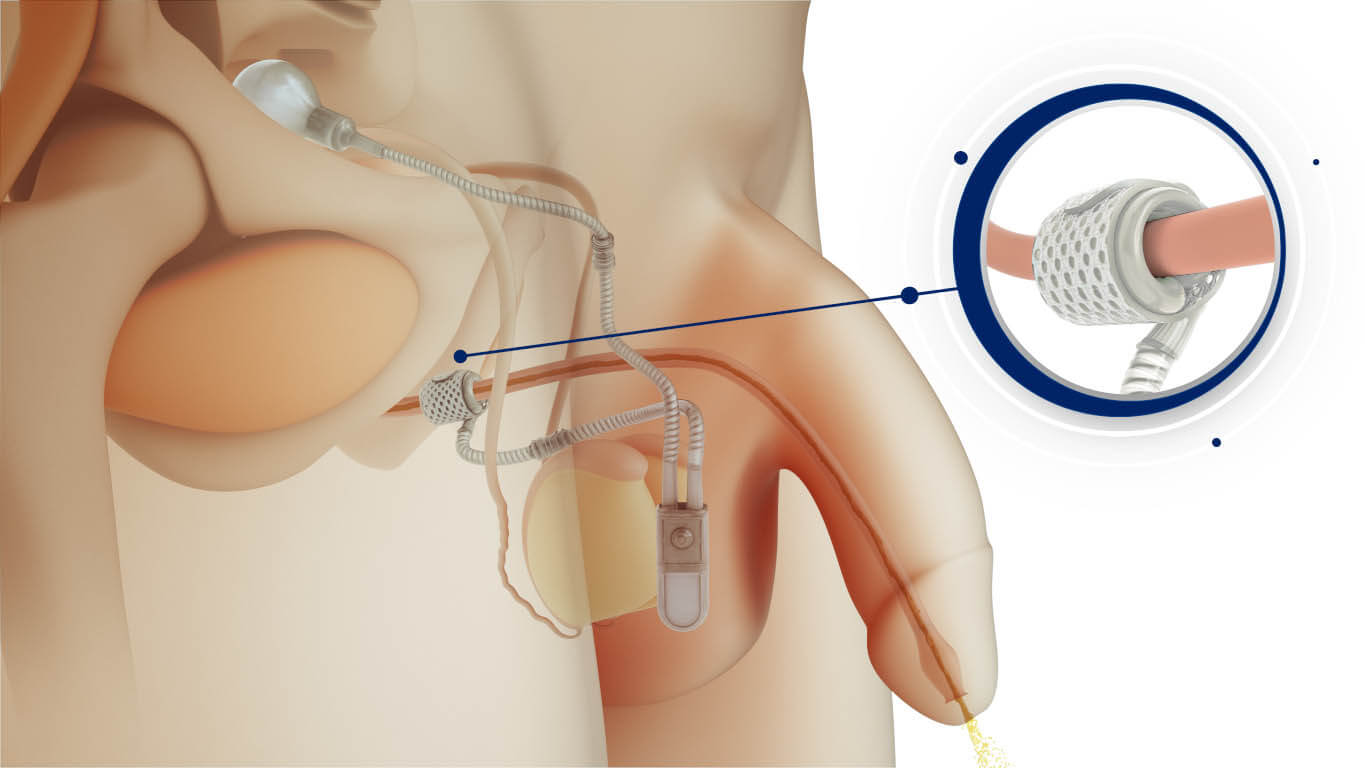URINARY INCONTINENCE QUIZ
Take this simple quiz to understand the severity of your bladder leakage symptoms, taking ~2 minutes to complete.


Rigicon® Conti® Artificial Urinary Sphincter
Set Up A Consultation With A Patient Consultation
Get free information about artificial urinary sphincters from our patient consultants. Book a time that works for you.
Rigicon® Talks Artificial Urinary Sphincter Videos
Top 10 Questions Answered about Artificial Urinary Sphincters
| Time | Question |
|---|---|
| 02:20 | How do I know if I am a candidate for the artificial urinary sphincter? |
| 04:15 | How does the artificial urinary sphincter work? |
| 06:35 | Can I choose the type of AUS I receive? |
| 10:12 | Will the AUS be noticeable to others? |
| 12:55 | What can I expect during recovery from AUS surgery? |
| 15:56 | How do I prepare for AUS surgery? |
| 20:50 | What should I discuss with my doctor before getting an AUS? |
| 26:35 | Can I still engage in physical activities with an AUS? |
| 30:33 | Can I have an MRI with an artificial urinary sphincter? |
| 31:55 | How long does an AUS last, and what is the likelihood of needing a revision? |
The Patient and Nurse Perspective in Prosthetic Urology
| Time | Question |
|---|---|
| 00:40 | What is the nurse's role in prosthetic urology surgeries, and how do nurses help patients prepare for the procedure? |
| 02:23 | How can nurses help patients manage their expectations and concerns before surgery? |
| 03:26 | What does the typical recovery process look like after surgery? |
| 05:19 | How does teamwork between nurses and surgeons impact patient care and outcomes in prosthetic urology surgeries? |
| 06:06 | What advice would you give to patients considering an implant? |
Types of Artificial Urinary Sphincters
ContiClassic®
Artificial Urinary Sphincter

Rigicon® ContiClassic® Artificial Urinary Sphincter is used to treat urinary incontinence due to intrinsic sphincter deficiency in cases such as incontinence following prostate surgery1.
ContiReflex®
Enhanced Artificial Urinary Sphincter

ContiReflex® Enhanced Artificial Urinary Sphincter's smart "Reflex Balloon" senses changes in intraabdominal pressure (IAP) and, in response, modifies the pressure on the urethra in response to this change in IAP.
Types of Artificial Urinary Sphincters
In the table below, you will find a comparison between two types of artificial urinary sphincters:
– ContiClassic® Artificial Urinary Sphincter
– ContiReflex® Enhanced Artificial Urinary Sphincter
| Features | ContiClassic® | ContiReflex® |
|---|---|---|
| Pressure Regulating Balloon | Classic | Smart Reflex |
| Hydrophilic coating for reduced infection risk | ✓ | ✓ |
| Rigicon Duality | ✓ | ✓ |
| Control Pump | ✓ | ✓ |
| Reservoir | ✓ | ✓ |
| Free consultation* | ✓ | ✓ |
*You can get free information about all artificial urinary sphincters from our patient consultants 24/7.
Before and After Surgery
You will be asked to visit the clinic of your choice to be checked for your eligibility for the artificial urinary sphincter surgery. It is our duty to guide you through this important process.
You will be called by experts to understand the severity of the condition
You will be asked to visit the clinic in order to be checked for your eligibility of the artificial urinary sphincter surgery
Date of your surgery will be decided upon your arrival
Your physician will take good care of you
Your condition after the surgery will be evaluated by your physician
URINARY INCONTINENCE
URINARY INCONTINENCE

Urinary incontinence (UI) is an involuntary or unwanted loss of urine. If incontinence is frequent or affects your quality of life, it is important to seek help.
All About UITREATMENT OPTIONS

Urinary incontinence in men is a treatable condition. Rediscover your happiness. Regain your confidence. We are here to assist you.
TreatmentsGET YOUR SCORE
Understand the link between your symptoms and stress incontinence. Take the assessment to help assess severity and find local support.
Bladder Leakage QuizMORE SIZE OPTIONS

Additional anatomical cuff sizes to offer a better chance at continence.
Talk to a SpecialistYOU ARE COVERED

Offered with the best in class warranty policy1. Bladder leakage is more common than you think. There is a trusted, safe treatment for it. Learn more about the gold standard treatment here.
Ask Questions to ExpertFINANCIAL OPTIONS

Whether you want to explore your options in public centers or private centers we can support you. Fill out the form to learn more.
Request InformationFAQ
What is urinary incontinence?
+Stress urinary incontinence, or "SUI" for short in English, is when urine leaks out. This occurs when suddenly the pressure is put on the bladder and urethra. This pressure causes the sphincter muscles to open briefly. When these muscles open, urine leaks out. In the cases of mild stress urinary incontinence, pressure may be due to sudden forceful activities, such as doing exercise, sneezing, laugh or coughing. In the most serious cases SUI, escape occurs during less forceful activities, such as getting up, walking, or bending over. The accidents" urinals of this type, maybe just a few drops of urine or enough to wet clothes.
Types of incontinence
+Urinary incontinence is a problem related to
loss of urine control. There are two main types:
• Stress urinary incontinence (SUI): When a small or moderate amount of
urine leaks out of control. This occurs by
coughing, sneezing, or laughing.
• Urge urinary incontinence (UUI) or overactive bladder (OAB). ): A sudden and uncontrollable urge to urinate.
Leakage is moderate to significant.
What are the causes of urinary incontinence?
+Among the most common risk factors for incontinence
urinary stress are:
• pregnancy and giving birth
• injury to the nerves of the lower back
• smoking (causing coughing)
• cough for life
• being overweight.
What are the symptoms of urinary incontinence?
+The main symptom of stress is urinary incontinence
when urine leaks during any activity that
puts pressure on the abdomen. These "accidents" of leaking urine may be just a few drops or enough
to wet clothes.
Treatment options urinary incontinence
+
Sometimes, conservative or pharmacological treatments may not improve urinary incontinence. In such cases, other treatment options are available. Together with your doctor, you can decide which approach is best for you, considering the potential benefits and side effects of each option.
Surgical treatment options for urgency urinary incontinence include:
- Bladder wall injections: A substance is injected into the bladder wall to prevent involuntary contractions.
- Nerve stimulation (neuromodulation): Electrical pulses are used to stimulate the sacral nerves, which control bladder function.
- Bladder enlargement surgery: This is typically a last resort when all other treatments have failed, and it is rarely performed today. If recommended, it is essential to discuss its potential side effects and implications with your doctor, as they can be significant.
Surgical treatment options for stress urinary incontinence include:
- Suburethral slings: A sling is placed under the urethra to support it.
- Bulking agents: A substance is injected into the urethra to increase its resistance.
- External compression devices: Devices designed to compress the urethra and prevent leakage.
Second-line treatment for urgency urinary incontinence
Sometimes, self-management or prescribed medications do not improve urgency urinary incontinence (UUI). In such cases, alternative treatment options are available, and you can decide the best approach with your doctor.
Common second-line treatment options for UUI include:
- Bladder wall injections
- Nerve stimulation (neuromodulation)
- Surgery to enlarge the bladder
Bladder surgery
If symptoms do not improve with medication or other treatments, bladder surgery may be required to increase the bladder’s capacity. This procedure helps reduce pressure in the bladder, allowing it to hold more urine.
During the procedure, the doctor makes an incision in the lower abdomen and uses a section of the bowel to enlarge the bladder. This surgery is called bladder augmentation or cystoplasty and is rarely performed today. If it is recommended, you should thoroughly discuss the potential risks and side effects with your doctor.

Surgical treatment for men with SUI
+
If you suffer from stress urinary incontinence (SUI), your doctor will examine and advise you of your treatment options.
Men at risk of developing urinary incontinence, such as those whose prostate has been removed (partially or entirely). Since the prostate surrounds the urethra, helping it resist the pressure of a full bladder, its removal can decrease the amount of pressure the urethra can resist, leading to urinary leakage.
There are options to improve or cure your condition. All procedures aim to make your continent. How this is done varies. Together with your doctor, you can decide which approach is best for you, based on:
- Your age
- Your general state of health
- The severity of your urinary incontinence
- How bothersome your symptoms are
This section offers general information and situations which can vary in different countries.
| Surgical Treatment | Description | Recommended For |
|---|---|---|
| Standard | ||
| Artificial Urinary Sphincter (AUS) | External compression of the urethra* using a hand-controlled pump. | Men with moderate to severe urinary leakage of a particular type. |
| Sling Implantation | A band-like structure used to compress the urethra. | Men with mild to moderate urinary leakage of a particular type. |
| Adjustable Slings | A band used to compress the urethra, which can be adjusted later if needed. | Men with mild to moderate urinary leakage of a particular type. |
| Special Situation | ||
| Bulking Agents | A substance injected into the urethral wall to improve closure. | Men with mild urinary leakage who are not eligible for major surgery, only expect a short-term benefit, or wish to delay standard surgical treatment. |
*The urethra is a tube that allows urine to pass from the bladder.
*The urethra is a tube that allows the passage of urine from the bladder.
Artificial Urinary Sphincter (AUS) implantation
+ 
Artificial urinary sphincter (AUS) implantation is the standard treatment for moderate to severe stress urinary incontinence.
The AUS allows you to control your bladder with a hand-operated pump to compress and release a cuff around the urethra. The AUS consists of:
- An inflatable cuff placed around the urethra
- A reservoir to store liquid and keep the pressure in the system and placed into the belly
- A valve or pump to control the cuff and placed into the scrotum
The goal of the AUS is to reduce urine leakage during activities such as sneezing, coughing, running, or lifting weights.
The AUS can have complications, such as mechanical failure or infection, which implies its removal.
RIGICON AU

Rigicon Australia
Rigicon Pty. Ltd. Unit 7, Level 1 Building A, Botany Quarter 11-13 Lord St, Botany NSW 2019




